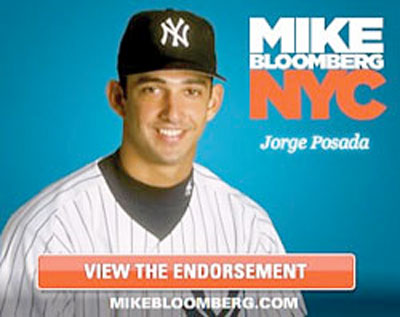Let me first say that I hope this blog entry doesn’t ruin my sister’s chances of marrying Jorge Posada.
 I noticed these Jorge Posada/Mayor Bloomberg ads on The Awl
I noticed these Jorge Posada/Mayor Bloomberg ads on The Awl
last Tuesday. “Did they press ‘submit’ on those ads the as soon as Posada
caught that last Rivera pitch on Monday night?” I wondered. Some deft Google work on my part determined that no, the ads had been running since the end of September, neatly timed with the release of Posada and Mrs. Posada’s (err…sorry, Aliza) book. New York Magazine reports that jointly, the Posadae endorse our current Mayor–though poor Mrs. P. doesn’t get her photo in the banner ads–saying in a press release, “He can hit, throw, field and lead a team, all without missing a beat.
We proudly pledge our support to the City’s all-star Mayor, Mike
Bloomberg.” Oh-boy.
I have never worked in politics, but as a casual observer who thinks a lot about publicity, I don’t think it’s a good idea to have a player from only one New York sports team endorse you. Sure, the Mets were an unmitigated disaster this season, but that’s hardly germane to their having many, many fans who are voters. I asked my friend Ben Wyskida, Publicity Director for The Nation (see the **exclusive** Life’s a Pitch interview here) for his thoughts:
“The Yankees are Manhattan’s team and Bloomberg is Manhattan’s Mayor. I’m not sure what a Mets fan would think of this. Also, I wish these ads reminded voters what a horrific stadium deal Bloomberg cut with the Yankees, costing the city millions in revenue and leaving school children in the Bronx playing baseball on Staten Island, instead of on the new parkland they were promised. But they won’t. Frankly, I do think in local politics it’s good to get sports heroes involved, but you have to get a few, from the different teams.”
Moving on from Bloomberg’s PR choices, I was thinking about how interesting it is every time a baseball player (orchestra player, ensemble member) is pulled out of their group into the solo spotlight. I don’t think I’ve ever seen Posada on his own; Jeter, yes, all over the place, including in bobblehead form on my desk and in my dreams every night, but not Posada. I spent a good chunk of last week in Utah with my clients The King’s Singers. Even when a new member joined the group last year, we didn’t concentrate the press on him. Sure, he did a few interviews about “being the new King’s Singer,” but the focus was on how his joining would affect the group, what the group’s process for selecting a new member was, what was ahead for this new incarnation of the group. Watching two of their concerts last week, I noticed that the individual members don’t even bow after one has a solo. The soloist may gently nod slightly more than the other members during the applause, but even in performance the emphasis is completely on the group.
On the one hand, I think orchestras, baseball teams and ensembles are significantly more interesting to watch when you know the personalities and interests behind the players. One of the New York Philharmonic musicians, for example, was profiled in Runner’s World because he is, you guessed it, a runner. Similarly, one of The King’s Singers, Paul Phoenix, loves cars; would his being profiled in Car and Driver help the group reach a different audience? Of course. Would I, as the group’s publicist, feel strange about pitching a solo profile of him without pitching solo profiles elsewhere for the other five? Absolutely. I felt weird typing his name just now! David Hurley, Timothy Wayne-Wright, Philip Lawson, Christopher Gabbitas and Stephen Connolly – there! Now I’ve mentioned them all.
I’m curious to hear how other publicists for organizations and ensembles handle this. Is it more effective to divide and conquer–that is, pitch stories for individuals when and where they come up–or to push a group’s image and persons-alities above all else? Individuals are what make the groups, and basically everything in this world, interesting, but the group is what’s powerful and, ultimately and presumably, what people want to see and hear. How much stronger would a Yankees endorsement of Bloomberg have been, for example, rather than just a Jorge Posada endorsement?
All that said, let’s go Yankees! It is my opinion as a Public Relations Professional that winning the World Series in your new stadium will result in Good Publicity. That’s a little free advice from me to you, Joe Girardi.

As a runner and classical music concertgoer, I quite enjoyed the Carter Brey feature in Runner’s World that you referred to above.
As someone from the legions who hate the Yankees, go Pedro and Chase. Rooting for the Yankees is like rooting for…well…I don’t think there’s a good analogue in the transitioning industry that is music.
I think it all depends on what kind of story you’re after. Some stories are better with a collective group image, others might be better served with one or a couple of players highlighted. If your city’s magazine wants to feature some of the most eligible bachelors, you can’t pitch the whole group, but maybe you can pitch a couple of eligible young players that can shine with their own personalities. But then if that magazine is doing a story on the orchestra or ensemble itself, or even the music industry etc., you probably pick someone who can speak on behalf of the group and represents the group’s character (assuming not all 100+ members will be interviewed 😉 )
Your Runner’s World example made me remember when I had the Golf Channel in for a piece on why golf is like classical music. One of the players was an avid golfer and compared different music to different players. It was great!